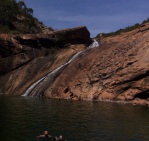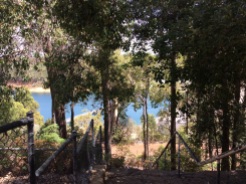‘ A terrible beauty is born’ is a line from a poem by one of Ireland’s greatest poets, W.B.Yeats. who died on this day, January 28, in 1939. This line came to mind as I witnessed several bush fires in Western Australia. Bush fires can be catastrophic events, resulting in loss of life or serious injury, devastating loss of property, (46 homes were destroyed in a fire near Perth in 2014) flora and fauna and general disruption by way of evacuations, road closures, power cuts and smoke. Emergency phone Apps beep, the sound of fire engines and police sirens fill the air, helicopters chakk-chakk-chak-chak overhead, planes circle. Here bush fires are fought from the air as well as the ground. In the air, water bombing aircraft and ‘helitacs’ douse the flames, while career and volunteer firefighters and rescue personnel swing into action on the ground, often putting their own lives at risk. Bush fires can move very quickly – often at several kilometers an hour, and are fanned by strong breezes. The tinder dry vegetation is the fuel that makes them catch hold very quickly.
On the other hand, palls of smoke produce wondrous skyscapes, and I am a big fan of the sky! In the past few weeks there have been 4 major fires

This fire was started deliberately by an 8 and 9 year old!

Smoke billows into the air

This fire was under control then flared up again when wind changed direction

This fire is out of control and moving through a forest

This fire was started accidentally by a spark from farm machinery
The smoke can cause breathing difficulties for those of us with chest conditions, and even if it can’t be seen, the smokey smell can be in the air and even inside the house for days on end.

Heavy palls of smoke block out the sun

This was taken mid afternoon
Looking a bit like the Crab Nebula, the sun is blotted out
A smoke-filled sunset

Fires can burn for anything from a few hours to a few weeks. Afterwards there is a huge logistical clean up operation, that may include replacing hundreds of burned poles, washing power lines as can be seen here, searching for injured wildlife, etc.
The ‘bush’ is stripped of all low growing vegetation, with only some eucalyptus and grass trees still standing. These particular species can withstand fires and will regrow, but the swathes of beautiful flowering trees and shrubs are gone. Gone too is the wildlife – snakes, birds, kangaroos, wallabies, – their rich habitat lying naked and destroyed.
Although denuded and apparently dead, Australia’s bush will rejuvenate itself very quickly after fire, and it will be interesting to see how long this particular devastated area takes to regrow and return to its natural state. However long it takes, a terrible beauty will be born, with wondrous plants,flowers and wildlife.
How fortunate we are here in Ireland not to have to deal with these emergencies, although on a day like today with snow and sleet warnings, some heat would be very welcome!
SOCIAL BRIDGE ~ Jean Tubridy connecting with you from Ireland

























































